
|
Adrienne Hood Jacqueline Spafford |
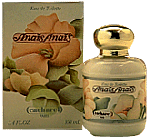 |
| The Journal for MultiMediaHistory Volume 1 Number 1 ~ Fall 1998 |

|
Adrienne Hood Jacqueline Spafford |
 |
| CONTENTS | |
|---|---|
| |
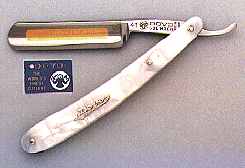 |
Bruce Retallack's Web site. |
We should point out here that we are aware that many people are working with instructional and research Web-based projects that far exceed this one in sophistication. There are even more people, however, who are beginning to see the advantage of integrating Web sites into their curriculum but have not yet taken the first step, due to such factors as technophobia, lack of facilities, lack of time, or lack of departmental support. We encountered all of these in varying degrees and will address them here. Our hope is that by discussing the problems we overcame, the difficulties we are still encountering, and, more importantly, the successes we achieved, that other people might consider taking the first step towards working with this important new communication technology. THE FIRST YEAR - 1996/97to encourage the use of the Internet as a research tool to add a new dimension to the exploration and use of objects and images to stimulate thinking about design and organization elements to explore the presentation of information in a non-linear format to encourage the incorporation of illustrations, photos, and graphics into text to provide practical computer skills that participants could take with them into other courses, the workplace, and ongoing individual Web projects
Computer Literacy
The largest problem we initially encountered was the unevenness of
the participants' computer abilities, including the instructor's. They
ranged from a level of comfort with a variety of computer applications
(two to three students out of a class of sixteen) to near computer illiteracy (surprisingly,
the majority). This was magnified by the near-terror on the part of those students
with little computer experience—some contemplated dropping the course
when they considered the overwhelming project that lay ahead. In addition,
while Hood appreciated the possibilities of the Internet for creating exciting
new ways to communicate history, she soon discovered that she had no idea
how to create a Web site of her own, let alone how to teach this to others.
One of the university's academic computer facilities, Information Commons,
was very enthusiastic about the project and had promised assistance, thus
she proceeded, thinking it couldn't be too difficult. She soon found out
otherwise.
Equipment and University Support
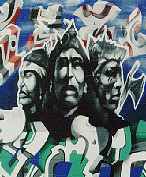 |
Erica Phillips' Web site. |
Unfortunately, it only became clear that the university was not yet equipped to deal with a project like this, with all of its difficulties, after Hood had built it into her syllabus. Furthermore, the computer administration at UofT was complicated, as there were two facilities with which we had to deal. The "Centre for Computing in the Humanities and Social Sciences"—now "Computing in the Humanitites and Social Sciences" or CHASS—supplies support for graduate students and faculty, and provides the server for graduate e-mail accounts and personal Web sites. "Information Commons" sets up e-mail accounts for everyone, especially undergraduates, and is responsible for listservs, another electronic component of the course Hood had established as a forum for discussion and problem solving. This latter group does not, however, provide space for personal Web sites. We were obliged, therefore, to deal with both facilities, confusing to a neophyte since it wasn't always clear who did what. At a time when the technical support for the entire university was in transition, politically it was important to deal with each sensitively.
Tackling the Problems - Funding
Around this time Hood met with Jacqueline Spafford, and together
they began to tackle some of the problems. Spafford was auditing "Topics
in Material Culture" out of interest in 1996. While working toward her
M.A. (Art History), she had taken a course in Computing in the Humanities
at UofT, and attended the CETH (Centre
for Electronic Texts in the Humanities) summer session at Princeton
University. These helped her develop a solid grounding in various computer
and Internet applications. She had also worked on numerous Internet projects,
designing Web sites for several university departments and conducting Internet
training for small groups. When Hood told her of the problems she was encountering,
Spafford suggested they try to get funding to allow her to teach some computer
sessions for the course. Since Spafford had done freelance work with CHASS,
she approached them first. We submitted a proposal which included an outline
of the course and the objectives for including the website component. Our
estimate was eleven hours to get the class up and running on HTML (HyperText
Markup Language), to help Hood get up to speed on Web basics, and to create
a course homepage. CHASS agreed to provide funding for the specified hours;
surprisingly this turned out to be the easiest part of the organization.
HTML Instruction
Hood initially donated two three-hour sessions of class time. Spafford
began each with a brief introduction to the concept of the World Wide Web,
and the mechanics of browsers. She then distributed handouts
on basic HTML coding, and used an enlarged projected image to analyze
a few fairly basic Web sites by contrasting the browser view with a view
of the same file as encoded text, using two
open windows.
The first session was fairly disastrous as it was next to impossible to find the appropriate level at which to instruct. The participants who had no computer experience beyond word processing (many still on DOS-run systems) felt discouraged by the bombardment of new information, while those who were capable of moving more quickly were frustrated by the attention paid to basics. The second session went much more smoothly. Students were instructed to bring in a diskette with the word-processed document file of whatever research they had completed. Spafford showed them how to convert it to ASCII (non-formatted text) and then how to add HTML coding. The computers were unfortunately not outfitted with HTML editors, so students had to use Notepad, which required them to type in the HTML, rather than using software which would add the coding at the click of a button. Although somewhat inefficient, this proved to be beneficial as it forced the students to think about the coding logically and thoroughly, and they quickly learned from their mistakes. We also took advantage of various Web sites with archived gifs (digitized pictures which can be easily copied into one's own site), icons, and background patterns. By the end of this session, they each had a simple page which incorporated a variety of fonts, display variations, colors, images and hypertext links. This was a powerful way for them to see the possibilities opening up; they were subsequently less daunted by the whole enterprise, and showed new enthusiasm about continuing.
The Course Homepage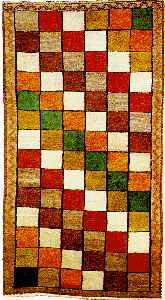 |
Robin Linley's Web site. |
 |
Jane Griffith's Web site. |
In the second of these two sessions, the focus was on adding images to the sites. In another part of the library building CHASS had a room equipped with a scanner which could be booked by the hour. It was made available to us and we initially reserved it for a two-hour session. We told students to bring some images to enhance the research included in their sites. Spafford scanned these, saving them as fairly low-resolution gifs (left). She made minor corrections and alterations in Photoshop 3.0, an image manipulation program that was loaded on the same computer. Several students found and incorporated related images on the Internet, which Spafford had shown them how to copy and transfer (right).
Uploading the Sites
All but one student managed to have their pages finished by the deadline,
although not all hurdles were overcome. There was a further problem with
the graduate/undergraduate split when students began to transfer their
sites to the server. Graduate students could set up their own homepages using their
e-mail accounts on the CHASS server, but undergraduates did not have this option
with their accounts, which were mainly on the Information Commons server.
Numerous phone calls and e-mails did not lead us to a solution, so as a
last resort we decided to have undergraduates hand in their completed Web pages
and accompanying images on a diskette and we loaded them into a subdirectory
on Hood's account.
Graduates, meanwhile, needed to be shown how to upload their work to the CHASS server, using an FTP (File Transfer Protocol) program. Since there was neither a computer classroom free at this time nor money available to hold another session, we put this together rather informally. Spafford posted detailed instructions on the class listserv on how to access and use the FTP program included in their e-mail software package, and a step-by-step lesson on how to create a directory and then upload their work. Some required several attempts, and assistance from one of us, but eventually all the sites were up and running.
Despite all the problems, the students came away feeling they had gained a useful skill and had successfully entered the world of the Internet. Hood had also learned many new things and had managed to survive all of the demands of this undertaking. Based on the high level of student enthusiasm resulting from the first attempt, she assigned a similar project for her 1997-98 class. Hood felt that all her goals had not yet been attained, due mainly to the technical and logistical problems we encountered, and she hoped that this could change next time. (See: Menu of all 1996-97 student Web sites.)
THE SECOND YEAR - 1997/98
 |
Christopher Martinello's Web site. |
Lynn Holden, academic technology liaison at Information Commons, came in during the second class meeting to give a session on design from a fairly conceptual viewpoint. This proved to be somewhat premature as the students had not even gone over the basics of Web site creation and found the concepts hard to grasp. While design is an integral component of Web construction, in future years this session will be much more valuable given later in the course, once students have a better understanding of this new area and of their individual research projects.
Spafford donated her time early in the semester to give two sessions on Internet basics, HTML, setting up a Web site account and FTPing. After the previous year's experiments, things went much more quickly and smoothly in these two sessions, and by the end of the second session each student had a preliminary site mounted on the Internet.
There were many more options offered the second year through CHASS and Information Commons. Several of Hood's students took free sign-up courses on basic to advanced Web site design; these helped them to learn more quickly and systematically. Also, CHASS provided the time of their Information Officer, Claire Smith, to teach two three-hour sessions, which consolidated much of the earlier information and also gave students the option to develop more advanced design strategies, such as the incorporation of tables and frames.
Varying student interest in the project was evident at this point. Some of the sites remained basic but functional, while other students developed fairly sophisticated layouts and continued work on them after the deadline. (See: Menu of all 1997-98 student Web sites)
IMPACT ON CURRICULUM |
Lisa Fox's Web site. |
Can one justify this extra load on very busy people? It does seem worth it based on one student's comment: "I believe that the inclusion of the Web site component of the course was one of the most valuable experiences of the entire M.A. program." In reality, however, most of the class agreed that the course requirements were too heavy with the Web page construction demands included. So far content has not been sacrificed, but for the price of student overload. This will necessitate rethinking the course structure to keep the basic curriculum intact while still doing the Web assignment.
Content
Hood simply added Web page construction to the regular course assignments
without realizing how much extra time the students would have to devote
to it. In the first year, when a less complex Web site was expected of the
students, time was not too problematic. In the second year, when each person
was required to have a fully functioning site of their own design and construction,
time became a major factor. Although the seminar is a full year long, it
originally met only two hours per week. The addition of a third hour in the
second year permitted some Web site instruction to be built into class time
without sacrificing content.
As a theory course that introduces students to the use of objects as historical sources, all class members are required to produce an original piece of research on a topic of their choice. Beginning with the material evidence, students then move outward to include as many different types of data as possible. The first-term assignment is an introduction to the research, including artifact analysis, annotated bibliography, and a strategy of work to be completed in the following term. Having built what she considered to be an appropriate amount of time into the second year of the project to teach the basics of Web site construction and image scanning, Hood required all students to present their first assignment as a Web site. She stressed, however, that content was more important than form at this point so that those too challenged by the Web page requirement could hand in a traditional paper. This did not excuse them from creating a Web site, it just gave them more time to tackle it.
Almost all of the students rose to the challenge and presented their first assignment—very credible Web sites they had created themselves, with images and basic navigational tools. Content difficulties seemed to rest more with the student's lack of familiarity with material culture methodology than with the mode of presentation. What is difficult to assess, however, is the extent to which some students were so intrigued and/or frustrated with the mechanics of Web site building that they sacrificed time they might otherwise have spent researching their topics. It is likely that some of this did occur.
During the second term, the students were expected to update their sites, but they were on their own in terms of scanning extra images, or adding finer points of design such as tables or frames. Although Hood had initially intended to evaluate the sites periodically throughout the term, she found that it was most realistic (both in terms of her time and the students') to do a concluding assessment at the end of the year about a week after the deadline for term work. The final project was to be a traditional paper in the hope that working back and forth between the two mediums would further enhance the students' awareness that there are important differences in communicating in these different formats.
Evaluation
One area which continues to be problematic is the grading of the Web sites.
Not only did Hood have to evaluate the content, she also had to comment
on and assess the design and construction of the Web site. Moreover, it
is difficult to provide commentary, to make suggestions, and to correct
grammar without a hard copy. Thus, every Web site had to be printed
out in its entirety to permit the addition of written comments for all
the linked sections before it was handed back. This two-pronged grading
was incredibly time consuming, not to mention paper-
and toner-intensive. In the future, each student will be required to hand
in printed versions of their sites.
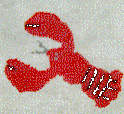 |
Sandra Shaw's Web site. |
A related issue has been determining the percentage of the course grade to be devoted to the website. In the first year it was fifteen percent and the students got a good grade for just doing a basic site. Things had been so difficult, it didn't seem fair to critique them too closely. In 1997-98, because the Web site design was integrated more thoroughly with the research projects, the first-term assignment presented as a Web site was worth thirty-five percent of the grade. In reality, content was weighted over Web page construction, but this was counterbalanced by giving a separate Web grade at the end of the year. It became clear over the course of the project, however, that some students put a lot of extra time and energy into learning more than just the basics and into thinking about how to design a good site. These students should be rewarded for the extra effort, while those who are not so inclined should not be penalized unduly. As a result, next year will probably see a return to the assignment of separate grades for each component.
COPYRIGHTSomewhat related is the issue of crediting references and of "footnoting." The students are still working out the most effective way to do this on their sites. So far hyperlinks to a list of anchored references in a separate file has been most popular. By the end of the course, I found the students getting more creative with this in a way that permitted appropriate academic citations while not interfering with the layout of the site.
ONE SEMESTER?
Although this seminar has the luxury of a full year in which to incorporate
the Web building project, it could be accomplished in a semester. Realistically, regardless of the course length, it will always take some extra
work on the part of the students over and above the regular academic requirements.
Perhaps the only way around this is to subordinate content in a course
that would be designed first and foremost to teach Web construction skills.
This may be more feasible down the road as universities and faculty become
more broadly convinced of the advantage of acquiring and teaching such
expertise. Well-constructed syllabi, with judiciously placed Web training
classes and carefully conceived assignments, could be incorporated into
a single-semester class without sacrificing content. A caveat is in order
here, though. Not all courses (or their instructors) are suited for this
type of exercise. One of the most important lessons we are learning from
early applications of hypermedia is that the worst thing one can do is
to use it just because it is seems new and trendy. It is essential to work
out in advance whether or not the extra time and effort it will take will
truly enhance the academic and pedagogical goals.
IS IT WORTH
IT?
We would say yes, it is worth it, but would qualify our answer. Except
in the case of instructors who have extensive computer and Internet experience
and the time to put into teaching those basics, it definitely needs to
be a collaborative effort. In this case, Hood was not prepared
for the many technical and logistical demands she encountered, and was
fortunate in the first year that Spafford introduced her to the world of HTML and had a paid connection with one of the
university computing facilities. These facilities have subsequently expanded
their resources, and, perhaps more important, Hood is learning how to navigate
around them. Both CHASS and Information Commons have supported, and have
indicated they will continue to support, the project in various ways.
Early evaluation
 |
Kelly Wilhelm's Web site. |
Final Evaluation
By end of the course every student thought it was a useful exercise.
Time was a major factor, as was the need to do the coding manually. All
are happy to have the acquired the skill and think it will help on the
job market, and most felt it made them think about their research and how
to communicate it in different ways. (See Comments
from the Class of 1997-1998.).
FURTHER THOUGHTS
Working on this paper has made us take stock and re-examine the value
of our pedagogical experiment. There seem to be several questions that anyone contemplating
a similar undertaking should ask. They are posed below with some of
the solutions that have occurred to us—there may be many more:
 CKNOWLEDGMENTS
CKNOWLEDGMENTS
About the authors:
After ten years as a curator of textiles at the Royal Ontario Museum,
Adrienne Hood moved to the University of Toronto, where she is an assistant
professor of early American history and material culture. Her interest
in the student Web project developed from her museum experiences of communicating
information in an exhibit format combined with thinking about how historians
can communicate to a wider audience.
Jacqueline Spafford is a graduate of the M.A. program in art history
at the University of Toronto. She is interested in combining art history
with the Internet and other multimedia applications. She currently works
at the Royal Ontario Museum, and beginning Fall '98 will be the Visual
Resources Curator at the University of California, Santa Barbara.
Student-Constructed Web Sites For Research Projects: Is It Worth
It?
~ End ~
Copyright © 1998 by the Journal for MultiMedia History
![]()
Contents: JMMH, Volume 1 Number 1 ~ Fall 1998